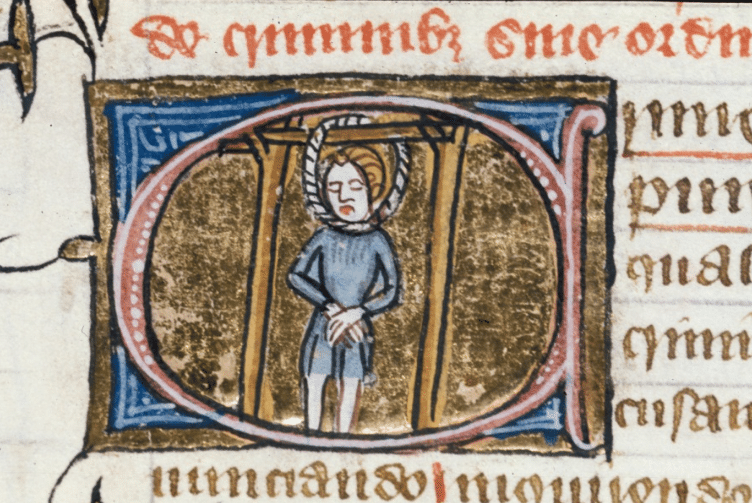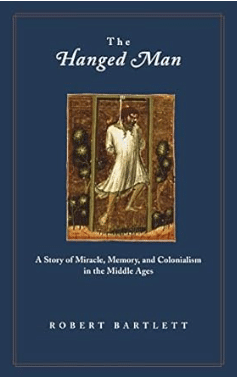Image: The Twice-Hanged William Cragh – https://medievalswansea.ac.uk/en/the-story/the-twice-hanged-william-cragh/index.html
Trail point 7
The Swansea Resurrection

The Swansea Resurrection
The True Tale of William Cragh – The Hanged Man Who Lived Again
In the shadow of modern-day Matthew’s House stands a story of faith, justice, and miraculous survival that continues to captivate historians and theologians alike. This is the story of William Cragh (also known as William ap Rhys or “scabby William”), a young man hanged on the gallows of Swansea in 1290, who was later reported to have returned to life — a tale intimately tied to the graveyard and former chapel of St John’s, now known as St Matthew’s Church.
Background: Rebellion and Retribution
In 1287, a Welsh nobleman named Rhys ap Maredudd, lord of Dryslwyn Castle, launched a revolt against the English Crown’s authorities in Carmarthenshire. He crossed the River Loughor into the Lordship of Gower, where discontented locals, including the 20-year-old William Cragh from Llanrhidian, joined him. William was poor and landless, claiming his lands had been unjustly taken by the local Norman lord, William de Braose.
Cragh had a reputation as a vagabond and rogue. During the revolt, he took part in the burning of Oystermouth Castle and attacks in Swansea, where the castle was damaged and people killed. The rebellion was crushed by early 1288, but punishment followed in the years after.
In autumn 1290, William Cragh and a fellow rebel, Trahaearn ap Hywel, were publicly executed on North Hill. The gallows, a simple timber structure of two forked uprights and a crossbar, had weathered Swansea’s elements. Cragh was hanged first. When Trahaearn, a larger man, was lifted, the beam broke, causing both bodies to fall. They were presumed dead but were rehanged on the uprights.
Lady Mary’s Mercy and the Unexpected Return
Following the execution, Lady Mary de Braose, wife of William de Braose, pleaded for the body of William Cragh. Though often speculated to have romantic motives, there was no relationship; she spoke Norman French and was from eastern England, while Cragh was a Welsh-speaking local. Like many noblewomen of the time, she was known to support the poor and disempowered.
Initially denied, she was eventually granted permission to retrieve Cragh’s body. Trahaearn ap Hywel was buried near the gallows, but Cragh’s body was transported, laid across a wooden wheel, first to St John’s Chapel — on the site of today’s St Matthew’s Church — then to the home of Thomas Matthew, near St Mary’s Church.
There, prayers were said by Lady Mary and her household, specifically invoking Thomas de Cantilupe, a Bishop of Hereford whose sanctity was revered. To the shock of all present, Cragh began to move, breathe, and eventually speak.
The Canonisation Process and Witness Testimony
Cragh’s recovery became part of the canonisation process for St Thomas de Cantilupe. In 1307, nearly 17 years after the event, the Vatican launched a formal inquiry. Evidence was taken from nine witnesses:
- Lady Mary, her stepson William, and their chaplain testified in London.
- William Cragh, a servant, a priest, a labourer, and others testified in Hereford.
Their statements, recorded in Latin, were preserved in:
- The Vatican Archives (Vat. Lat. 4015), and
- The Exeter College Manuscript 158, Oxford.
These documents revealed conflicting stories. Some claimed St John’s Chapel was locked. Others suggested Cragh may have begun to revive in the graveyard itself, even as burial was underway. The Hereford manuscript, written just weeks later, states:
“When they had begun to bury him, suddenly, to the amazement of all, he revived, pulled his hands and feet towards himself and began to speak.”
Lady Mary recalled he was carried to the chapel on a wheel, his limbs hanging limp, so harshly transported that even a healthy man might have died from the journey. She and her maidservants prayed fervently to St Thomas de Cantilupe.
A Miracle in Swansea
Two weeks later, Cragh — now fully conscious — sought an audience with the Lord of Gower, who spared him, remarking that God had restored him, and he would not undo that act. Cragh later travelled to Hereford to give thanks at Cantilupe’s tomb, still there today.
The tale was ultimately accepted by papal authorities. In 1322, Thomas de Cantilupe was canonised as a saint, with William Cragh’s case listed among 38 authenticated miracles.
Legacy and Local Connection
This event — the only known case of a documented resurrection from hanging in medieval Wales — took place partly on the grounds of today’s St Matthew’s Church, right outside Matthew’s House. It is a profound intersection of spiritual tradition, justice, medieval society, and the power of narrative.
Through manuscripts, testimonies, and centuries of preservation, the story lives on as part of Greenhill’s remarkable heritage.

Image: The Mystery of William Cragh, The Hanged Man of Gower – Andrew Dulley

Image: The Hanged Man – A Story of Miracle, Memory, and Colonialism in the Middle Ages – Robert bartlett
Sources & References
- Exeter College Manuscript 158, Oxford. Translation by Andrew Dulley, transcription by Ian L. Bass.
- Vatican Archives Vat. Lat. 4015 – Canonisation witness records.
- Richter, Michael. “William ap Rhys, William de Braose, and the Lordship of Gower.” Studia Celtica XXXII (1998), pp. 189–209.
- Dulley, Andrew. The Mystery of William Crach, the Hanged Man of Gower (2014).
- Swansea City Witness – Medieval Swansea Project
https://medievalswansea.ac.uk/en/index.html - Wikipedia Entry: https://en.wikipedia.org/wiki/William_Cragh
- Swansea City Witness Article: https://medievalswansea.ac.uk/en/the-story/the-twice-hanged-william-cragh/
- Dark Histories Article: https://www.darkhistories.com/william-cragh-the-not-so-hanged-man/
- Purchase “The Mystery of William Crach – The hanged Man of Gower by Andrew Dulley – https://medievalswansea.ac.uk/en/blog/index.html
- Purchase “The Hanged Man – A Story of Miracle, Memory, and Colonialism in the Middle Ages” – Robert Bartlett – https://www.amazon.co.uk/Hanged-Man-Miracle-Memory-Colonialism/dp/0691126046


